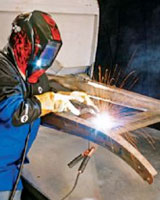Guide to Fabrication Jobs
Anyone who wishes to pursue a career path that involves skilled manual labor is encouraged by guide to fabrication jobs to think about a job in metal fabrication. According to guide to fabrication jobs, the field of metal fabrication has a lot of sub-sectors in which one can specialize. Before jumping into this exciting career, guide to fabrication jobs recommends that people learn more about the various vocations in the trade in order to make the right decision regarding their education and employment choices.
Sheet Metal Working and Welding Fabrication Jobs
Guide to fabrication jobs state that sheet metal workers create a wide array of projects that require using sheet metal. This may include making products such as metal roofs, railroad cars and heating ducts. Sheet metal workers must be proficient in using tools designed to join, shape and cut pieces of sheet metal. Those who want to specialize in sheet metal working can obtain the necessary training at many vocational schools and junior colleges. There are also programs that provide qualified students with sheet metal apprenticeships and on-the-job instruction. While certification is not always necessary, most U.S. employers prefer to hire certified sheet metal workers.
Welding is another specialty of fabrication according to guide to fabrication jobs. Welding is a skilled trade that requires workers to join metal pieces together by utilizing heat and electricity. Various manufacturing industries use welding, such as aerospace, automotive and shipbuilding. There are dangerous aspects a welder will encounter, like intense light and heat. Safety training and proper use of protective gear are covered in corresponding trade coursework. The U.S. Bureau of Labor Statistics shows that the welding field is projected to remain steady over the next few years. There will always be a high demand for skilled welders.
Steamfitting and Pipe Fitting Fabrication Jobs
Guide to fabrication jobs explain that pipe fitting and steamfitting both perform job duties such as joining and installing pipes as well as maintaining and repairing existing systems. Licensing requirements are left to the discretion of employers. Most opportunities are provide project-by-project and on a contract basis. This means that some pipe fitters and steamfitters will have difficulty finding steady work until they built a healthy network of contacts. The U.S. Bureau of Labor Statistics projects that the next 10 years will see a 16-percent job market growth in pipe fitting.
Iron Working Fabrication Jobs
When constructions are hired to build large commercial structures and bridges, they require iron working. Besides working on wide-scale structures, iron workers may be employed to reinforce concrete structures, roads and bridges. Physical fitness is a quality that all iron workers must possess. Since a lot of iron working is performed at long vertical distances, iron workers should not be afraid of heights. Welding plays a large role in the job duties of a typical iron worker. The guide to fabrication jobs says that 3-4 year-long apprenticeships are necessary to break into the iron working field.
Assembling and General Fabrication Jobs
Fabricators and assemblers put items together an usually work in the manufacturing industry. There are a wide variety of products created by fabricating and assembling. These specialists make use of soldering irons, rivet guns, brazers and other trade-related tools.

